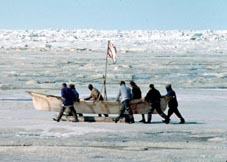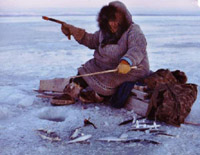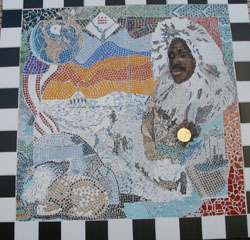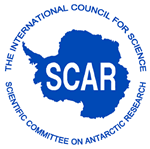Following investments in general science education stimulated by Sputnik and the International Geophysical Year of 1957, women emerged on the polar science scene in the 1980’s. Seeking to understand changes in Arctic climate, ice and biota in the 1990’s, researchers turned to native elders to learn from their observations and analysis. Despite these recent developments, women and indigenous peoples remain underrepresented in polar research. Workshop participants articulated the clear need of the polar science community to actively engage more diverse participation, including Arctic peoples and communities, underrepresented minorities, and women, as well as broadening economic and geographic involvement. Communication with Arctic indigenous peoples must include
developing a new generation of researchers from the Arctic who actively investigate and communicate northern issues to global populations and decision makers. This theme of building capacity within communities, together with providing opportunities for personal contact and field experiences, making polar issues relevant at the community level, and developing mentoring and support systems, was articulated for each target group.
 |
Whale Boat. Photo credit: Alaska Native Science Commission.
|
Networking diverse communities together through common interests can have long-lasting impact. For example, at the turn of the last century Matthew Henson played a crucial role in attempting to attain the North Pole, yet since that time minorities have remained underrepresented in polar science. A first step towards bridging the gap between inner city communities and communities in the Arctic was taken at the workshop where the leader of the Earth Conservation Corps’ Matthew Henson Center in Washington DC established contact with Native Alaskans and began to plan exchange programs. Unlike many of the other sciences, user data collected through the experience of San Francisco Exploratorium’s web-based "Live@" including "Science Live from Antarctica," indicates that polar themes draw a nearly gender-balanced audience. Polar education efforts should build on this latent interest to develop a more gender-diverse scientific community.Networking diverse communities together through common interests can have long-lasting impact. For example, at the turn of the last century Matthew Henson played a crucial role in attempting to attain the North Pole, yet since that time minorities have remained underrepresented in polar science. A first step towards bridging the gap between inner city communities and communities in the Arctic was taken at the workshop where the leader of the Earth Conservation Corps’ Matthew Henson Center in Washington DC established contact with Native Alaskans and began to plan exchange programs. Unlike many of the other sciences, user data collected through the experience of San Francisco Exploratorium’s web-based "Live@" including "Science Live from Antarctica," indicates that polar themes draw a nearly gender-balanced audience. Polar education efforts should build on this latent interest to develop a more gender-diverse scientific community.
Arctic Natives and Residents
In order to engage Arctic Natives and residents, workshop participants recommended gaining their active involvement in future working group meetings, and working to develop the respect and confidence of the native community and its residents. Mutual respect is essential for the science community to work with them. Science capacity within indigenous communities must be expanded so that native persons design and conduct research projects for native populations.
Specific Proposals:
 |
Icefish. Photo credit: Tommy Onktooguk. Courtesy of www.alaskool.org
|
- Develop a better working relationship between the indigenous community and the science community by carefully planning the timing and cultural structuring of meetings and events, and ensuring that researchers and planners have some background/training in cultural sensitivity and ethics such as existing guidelines from NSF, Alaska Native Knowledge Network (ANKN), and international first peoples organizations (http://www.ankn.uaf.edu, http://www.nsf.gov/od/opp/arctic/conduct.jsp). Highlight paradigmatic stories of respectful and successful collaborations between native communities and scientific communities. Develop a historical overview extending from the first IPY to the International Geophysical Year (IGY) and through current day.
- Focus on building capacity within indigenous communities for conducting research (including local collection of data) and education/outreach in both traditional and non-traditional venues. Community-based educational components should be developed for existing and planned long-term observation networks, structured like GLOBE projects and tailored by community members to address community relevant issues, and to involve both native elders and scientists. Arctic research projects by native people, for native people, will involve finding funding sources and connecting them with native communities. There can be varied tracks for community-based science education ranging from informal to certificate-track to graduate degree-track. Develop opportunities for all types of students.
- Recognizing that the Native peoples have knowledge and tradition to share with other populations is an important first step towards their involvement. Their presence in the field of education, both traditional and non-traditional will assist in encouraging more Natives, and in providing a bridge to other cultures. Science information existing in their people through their elders and collective knowledge and practices has a place in current and future research. Respect for preserving their traditions must be considered in any program.
Minorities
Building involvement in polar activities by minority communities requires actively reaching out to them, and ensuring that research and activities have relevance to their specific interests. Existing community agencies and activities can be a vehicle for numerous and repeated exposures on their home ground. Locating these agencies and local needs will involve physically going to communities and exploring possibilities face-to-face. Ongoing support systems for engaged minorities need to be established that will sustain them throughout their involvement in research.
 |
Mosaic at Matthew Henson Center,
Washington, DC. Photo credit:
Margie Turrin.
|
Specific Proposals:
- Focus groups can help in identifying ways to encourage minorities in their involvement in polar science and emphasize its relevance to them and their communities, and to develop local connections. Connect through professional minority associations. Find ways to offer hands-on, field participation by community members. Encouragement and recognition for involvement in science and research can have a major impact, anything from offering day care and meals to a modest stipend. It is important not to set the level so high at the beginning that people without a strong background are intimidated and therefore unwilling to participate. Courses can be restructured so that they are designed to be more informative than evaluation oriented. Seminar series with following group discussions, or individual presentations might be an alternative design to courses focused on traditional testing and evaluation.
- Better preparation in math and science is essential, especially in the grades K-6 as this is when the foundation for future learning is established. Integrating science and math with other fields is one way to expand relevance and motivation.
- Once people are involved it is important to develop a network of mentors to serve as active role models. Develop vignettes on minorities involved in science – their background, accomplishments and challenges to share with newcomers. Train non-minority scholars in successful approaches to mentoring minority students.
Gender Diversity
Polar exploration and science has historically been a field comprised predominantly of males, but strong female engagement in programs like the Exploratorium’s "Science Live from Antarctica," indicates that women have substantial interest in polar themes. This is a two-fold issue comprised of both the issues facing women choosing any science as a profession, as well as the issues facing woman who chose polar science. A change in the general culture and acceptance of science-oriented girls would address both issues. Systemic changes include broadbased goals such as: highlighting the successful women in science and encouraging them to serve as mentors to other women, more women in senior science positions to serve as role models, more support for women with children
who must do polar field work, "Reprogramming" parents so that they encourage girls to play with Legos and other technical toys, and teaching math and science in context in middle schools so that females and minorities don’t lose interest and miss out on building their foundation for college science. Addressing these and other items that have been raised in recent studies on women in science, will help with recruiting and retaining more women interested in polar science as well. Enhancing gender diversity also includes involving more male K-12 teachers as well as engaging more women in polar research.
Specific Proposals:
 |
Robin Robertson. Photo credit: Amy West, MT on Palmer Cruise.
|
- In order to understand what attracts women to polar science, collect data from the women presently in polar science. Survey female researchers to ask what inspired them to do what they do. Develop vignettes to share on these individuals, their background, accomplishments and challenges.
- Investigate why so many women are underemployed. Recognize contributions of part time employees and increase their status. Consider salary equity and benefits: offer benefits to part time employees and adjuncts. Examine ways to offer educational opportunities to people with a wider range of availability, for example, MA, MS and certificate programs that can be completed part time and after hours. Establish part-time science programs for nights and Saturdays, with childcare, so that working women can attend.
- Educational programs should deliberately attempt to engage the female population in science as well as the male population. Target middle schools with a focus to engage them in meaningful activities, and to teach more math. Middle school is a time when females and minorities lose interest in science, math, and technology so it is especially important to keep them engaged and not allow them to fall behind. Informal educational opportunities are often a good way to engage individuals who might otherwise not be involved. Provide materials for museums, and zoos,to engage the female audience, and take advantage of "virtual" experiences. Teach youth to appreciate nature at an earlier age (organize field trips, bring snow-making machines in the South, polar-themed coloring books,.). Create materials for wide distribution: recommended polar reading list, film lists.
- Develop a mentoring and support system. Encourage networking. Provide opportunities for teachers to work closely with researchers so that they can be role models for their students.
Geographic Diversity
From Louisiana to the Middle East and Asia, what are the keys to engaging people in diverse geographic settings in understanding and appreciating the poles? Engaging geographically diverse communities will involve personally connecting them to the research so that they see the relevance to their community. Focus on the impacts on the poles of decisions made elsewhere or the impact of polar change on other communities. Studies/activities that can be done in any location allow all individuals to be a part of the science research experience.
Specific Proposals:
- Meet with communities to find out what is important to them, how they relate to specific issues, and then make it personal. Identify issues and values that communities have in common with the poles, compare and contrast. Focus on connections between each community and the poles. For example, a rise in sea level caused by melting glaciers and ice sheets could directly affect the 1/3 to 1/2 of the US population that lives in the coastal zone. Provide an open framework so that communities can select what is important to
them to focus on (climate, biology, etc.) – communities relate to specific issues and should be able to plug their projects into this interest. Emphasize that local policies and practices are relevant to the changes in the global system and affect the poles.
- Provide contact information so that communities can connect with scientists and other like-minded communities to set up projects.
Socioeconomic Diversity
Scientific research, often requiring a PhD, seems beyond the reach to many socioeconomic groups. And so polar regions, literally at the ends of the earth, becomes an esoteric subject. To reach economically diverse communities will necessitate the better use of media and public information systems. The media and non-traditional educational opportunities should be a primary focus for reaching economically disadvantaged communities. Misconceptions about where scientists come from can be addressed through biographies of scientists who come from non-academic, and lower economic backgrounds. These biographies should be provided to teachers, parents and students.
Specific Proposals:
- Make connections between environment and local community – make it all relevant. Develop programs and activities that are appealing to all socioeconomic backgrounds.
- Create dramatizations about polar science for wide distribution to teachers and children. Make short public TV sections (like Sesame Street or Bill Nye) that teachers can use directly in their classroom. Give away posters with facts about the poles to teachers for use in classrooms (as well as PDF files, etc to download). Develop inexpensive programs and activities: fast food children’s meals with polar toys, explorer games and play cards, polar tic-tac-toe (if answer correctly can put down an X or an O), polar checkerboard. Engage scholastic publishing with polar topics and free books (containing polar information). Tap community/recreation centers and camps to diversify the outreach through informal science.
- Make polar research more accessible. Address the misconceptions about where scientists in academia come from. Publish the low-income success stories. Have an option to make an audio tape essay for applications to advanced degrees, since some applicants may be more articulate in speaking than in writing.
- Be vigilant – make sure that communities have proper resources (especially technology). Involve both students and parents. Make school resources available during non-school hours.
International Diversity
 Existing international projects show the tremendous success of scientists around the world working together. Large-scale, far reaching projects touch people around the world and highlight the fact that science is based on contributions from around the globe. The web and polar research, and specifically the IPY, all international by definition, are excellent vehicles for international outreach. Existing international projects show the tremendous success of scientists around the world working together. Large-scale, far reaching projects touch people around the world and highlight the fact that science is based on contributions from around the globe. The web and polar research, and specifically the IPY, all international by definition, are excellent vehicles for international outreach.
Specific Proposals:
- Focus on international issues that touch people across the world e.g., Antarctic Treaty, Ocean Drilling, Global Climate Change. Develop projects that allow citizens and/or students from around the world to contribute data or research (like project GLOBE), and then connect contributors with scientists, and provide them with information about how the data is being used, so they see that their contribution is valued. Work with large international groups who might be able to bring in financial support.
- Use communications that easily spans international boundaries. The web is global, and if language is a barrier, recruit young researchers from various countries to develop multilingual materials and translate for elders to break the barrier. Use non-Eurocentric language or symbols and photos and limited words (Japanese do this successfully). Use art and music to transcend language barriers.
- Engage international organizations, institutions and committees, for example, the Arctic Council, the University of the Arctic, the International Polar Foundation, Scientific Committee on Antarctic Research, International Arctic Sciences Committee.
- Promote and support the exchange of scientists and science students between countries for research and education. Prepare the scientists for the cultural differences they will face when they visit or relocate other countries. Increase international partnerships and understanding by encouraging students to study abroad as part of their science education and to collaborate in an international research project as part of their degree program.
 |
Satellite image of the Lena River delta with the Arctic Ocean on the top. Courtesy of NASA.
|
|
